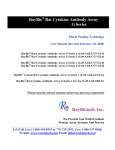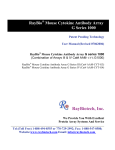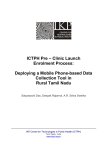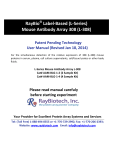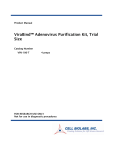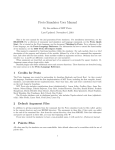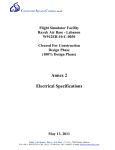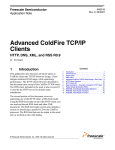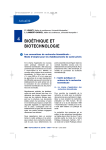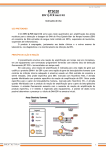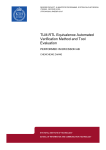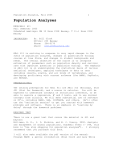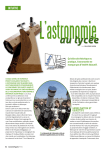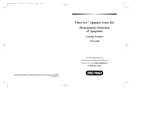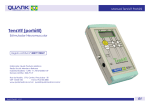Download RayBiotech, Inc.
Transcript
RayBio® Mouse Cytokine Antibody Array G Series 6 Patent Pending Technology User Manual (Revised March 6, 2009) RayBio® Mouse Cytokine Antibody Array G Series 6 (Cat# AAM-CYT-G6-4) RayBio® Mouse Cytokine Antibody Array G Series 6 (Cat# AAM-CYT-G6-8) RayBio® Custom Mouse Cytokine Antibody Array (Cat# AAM-CUST) RayBio® Mouse Cytokine Antibody Array Service (Cat# AAM-SERV) Please read the manual carefully before you start your experiment RayBiotech, Inc. We Provide You With Excellent Protein Array Systems and Service Tel:(Toll Free) 1-888-494-8555 or 770-729-2992; Fax: 1-888-547-0580; Website:www.raybiotech.com Email: [email protected] RayBiotech, Inc. RayBio® Mouse Cytokine Antibody Array G Series 6 Protocol TABLE OF CONTENTS I. Introduction……..……………………………... 2 How It Works………………………..………… 5 Materials Provided…………………………….. 6 Additional Materials Required………………… 6 III. Overview and General Considerations………… 7 A. Preparation of Samples……………………… 7 B. Handling Glass Chips ………………………. 7 C. Incubation…………………………………… 8 IV. Protocol………………………………………… 8 A. Blocking and Incubation……………………. 8 B. Detection……………………………………. 11 Interpretation of Results……………………….. 12 VI. Troubleshooting Guide………………………… 18 VII. Reference List…………………………………. 19 II. V. Cytokine Antibody Arrays are RayBiotech patent-pending technology. RayBio® is the trademark of RayBiotech, Inc. RayBio® Mouse Cytokine Antibody Array G series 6 1 I. Introduction All cell functions, including cell proliferation, cell death and differentiation, as well as maintenance of health status and development of disease, are controlled by many genes and signaling pathways. New techniques such as cDNA microarrays have enabled us to analyze the global gene expression 1-3. However, almost all cell functions are executed by proteins, which cannot be studied by DNA and RNA alone. Experimental analysis clearly shows a disparity between the relative expression levels of mRNA and their corresponding proteins 4. Therefore, it is critical to analyze the protein profile. Currently, two-dimensional polyacrylamide SDS page coupled with mass spectrometry is the mainstream approach to analyzing multiple protein expression levels 5,6. However, the requirement of sophisticated devices and the lack of quantitative measurements greatly limit its broad application. Thus, no simple, cost effective, and rapid method of analysis of multiple protein expression levels has been available to researchers until now. Our RayBio® Mouse Cytokine Antibody Array is the first commercially available protein array system 7-11. By using the RayBiotech system, scientists can rapidly and accurately identify the expression profiles of multiple cytokines in several hours inexpensively. The RayBiotech kit (G series) is a glass chip format. The kit provides a highly sensitive approach to simultaneously detect multiple cytokine expression levels from cell culture supernatant, patient’s serum, tissue lysate and other sources. The arrays are manufactured using non-contact arrayer. The experimental procedure is simple and can be performed in any laboratory. The signals from G series arrays are detected using a laser scanner. Besides the products listed in this manual, RayBiotech also provides RayBio® Mouse Cytokine Antibody Array G series 2000 for simultaneous detection of 144 mouse cytokines in single experiment. RayBiotech also provides RayBio® Human Cytokine Antibody Array G series 4000 which is the only product available in the market that can detect 274 human cytokines in single experiment. We also provide quantitative antibody arrays which can RayBio® Mouse Cytokine Antibody Array G series 6 2 quantitatively measure multiple protein expression in antibody array technology. Pathway-specific array systems allow investigators to focus on the specific problem and are becoming an increasingly powerful tool in cDNA microarray system. RayBiotech’s first protein array system, known as RayBio® Mouse Cytokine Antibody Array, is particularly useful compared with the Mouse cytokine cDNA microarray system. Besides the ability to detect protein expression, RayBiotech’s system is a more accurate reflection of active cytokine levels because it only detects secreted cytokines, and no amplification step is needed. Furthermore, it is much simpler, faster, environmentally friendlier, and more sensitive. Simultaneous detection of multiple cytokines undoubtedly provides a powerful tool to study cytokines. Cytokines play an important role in innate immunity, apoptosis, angiogenesis, cell growth and differentiation 12. Cytokines are involved in most disease processes, including cancer and cardiac diseases. The interaction between cytokines and the cellular immune system is a dynamic process. The interactions of positive and negative stimuli, and positive as well as negative regulatory loops are complex and often involve multiple cytokines. Reference List 1. LPS induces the interaction of a transcription factor, LPS-induced TNF-a factor, and STAT6(B) with effects on multiple cytokines. Tang X, Marciano DL, Leeman SE, Amar S. PNAS. 2005 ;102(14): 5132-5137. 2. HIV-1-mediated apoptosis of neuronal cells: Proximal molecular mechanisms of HIV-1-induced encephalopathy. Xu Y, Kulkoshy J, Pomerantz RJ. PNAS. 2004 ;101(18): 7071-7075. 3. Synergistic increases in intracellular Ca(2+), and the release of MCP-1, RANTES, and IL-6 by astrocytes treated with opiates and HIV-1 Tat. El-Hage N, Gurwell JA, Singh IN, Knapp PE, Nath A, Hauser KF. GLIA. 2005;50(2):91106. RayBio® Mouse Cytokine Antibody Array G series 6 3 4. Bone Marrow Stroma Influences Transforming Growth Factor-β Production in Breast Cancer Cells to Regulate c-myc Activation of the Preprotachykinin-I Gene in Breast Cancer Cells. Oh HS, Moharita A, Potian JG, Whitehead IP, et al. Cancer Res. 2004; 64:6327-6336. 5. Recombinant Herpes Simplex Virus Type 1 (HSV-1) Codelivering Interleukin12p35 as a Molecular Adjuvant Enhances the Protective Immune Response against Ocular HSV-1 Challenge. Osario Y, Ghiasi H. J Virology 2005; 79(6):3297-3308. 6. Dysregulated Inflammatory Response to Candida albicans in a C5-Deficient Mouse Strain. Mullick A, Elias M, Picard S, Gros P. Infect Immunity. 2004; .72(10):5868-5849. 7. Leukotriene B4 Strongly Increases Monocyte Chemoattractant Protein-1 in Human Monocytes. Huang L, Zhao A, Wong F, Ayala JM, Cui J. Arterioscler Thromb Vascul Biol. 2004;24:1783-1788 8. Giroux M, Denis F. Human CD1d-unrestricted NKT cells release chemokines upon Fas engagement. Blood. 2005;105(2):703–710. 9. Monitoring the response of orthotopic bladder tumors to granulocyte macrophage colony-stimulating factor therapy using the prostate-specific antigen gene as a reporter. Wu Q, Esuvaranathan K, Mahendran R. Clin Cancer Res. 2004; 10(20):6977-84. 10. Neuroglial activation and neuroinflammation in the brain of patients with autism (p NA). Vargas DL, Nascimbene C, Krishnan C, Zimmerman AW, Pardo CA. Ann Neurol. 2005; 57(1): 67 – 81. 11. Cytokine profiling of macrophages exposed to Porphyromonas gingivalis, its LPS or its FimA. Zhou Q, Desta T, Graves DT, Amar S. Infect Immunity. 2005; 73(2):935-43. 12. Veto-like activity of mesenchymal stem cells: functional discrimination between cellular responses to alloantigens and recall antigens. Rameshwar P. Journal of Immunology. 2003;171(7):3426-34. 13. The promise of cytokine antibody arrays in drug discovery process. Huang RP, Yang W, Yang Y, Flowers L, et al. Expert Opinion on Drug Discovery. (2005) 9:601-615. RayBio® Mouse Cytokine Antibody Array G series 6 4 Here’s how it works Array support Sample Incubation of Sample With arrayed antibody Supports Cocktail of Biotin-Ab Incubation with Biotinylated Ab 1-2 hrs 1-2 hrs Labeled – streptavidin Incubation with Labeled- streptavidin 2 hrs Detection of signals Data analysis and graph RayBio® Mouse Cytokine Antibody Array G series 6 5 II. Materials Provided Upon receipt, all components of the RayBio® Mouse Cytokine Antibody Array kit should be stored at -20°C. At -20°C the kit will retain complete activity for up to 6 months. Once thawed, the glass chips, Fluorescent dyestreptavidin and 2X Blocking Buffer should be kept at –20°C and all other component should be stored at 4°C. Use within three months after reagents have been thawed. Please use within six months of purchase. • RayBio® Mouse Cytokine Antibody Microarray slides (1 slide with 4 subarrays, 1 or 2 slides) • Biotin-Conjugated Anti-Cytokines (1 tube/4 subarrays, 1 or 2 tubes) • 1,500X Fluorescent Dye-conjugated Streptavidin (cy3 equivalent, 1 tube/4 subarrays, 1 or 2 tubes) • 2X Blocking Buffer (5 ml/10 ml) • 20X Wash Buffer I (30 ml) • 20X Wash Buffer II (30 ml) • 2X Cell Lysis Buffer (10 ml) • RayBio® G series antibody array accessory (including slide incubation chamber, Gasket, Protective cover, Snap-on sides and adhesive film) • 30 ml tube • Manual Additional Materials Required • • • • • Orbital shaker Laser scanner for fluorescence detection Aluminum foil Distilled water Plastic box RayBio® Mouse Cytokine Antibody Array G series 6 6 Layout of G series Array 6 Barcode III. Overview and General Considerations A. Preparation of Samples B. Use serum-free conditioned media if possible. C. If serum-containing conditioned media is required, use uncultured media as a negative control sample, since many types of sera contain cytokines. D. For cell lysates and tissue lysates, we recommend using RayBio® Cell Lysis Buffer to extract proteins from cell or tissue (e.g. using homogenizer). Dilute 2X RayBio® Cell Lysis Buffer with H2O (we recommend adding proteinase inhibitors to Cell Lysis Buffer before use). After extraction, spin the sample down and save the supernatant for your experiment. Determine protein concentration. E. We recommend using: • 50–100 µl of Conditioned media (undiluted), or • 50–100 µl of 2-fold to 5-fold diluted sera or plasma, or • 10–200 µg of total protein for cell lysates and tissue lysates. If you experience high background, you may further dilute your sample. F. Handling glass chips • The microarray slides are sensitive, do not touch the surface. Hold the slides by the edges only. • Handle all buffers and slides with powder-free gloves. • Avoid breaking glass slide. • Handle glass chip in clean environment. RayBio® Mouse Cytokine Antibody Array G series 6 7 G. Incubation • Completely cover array area with sample or buffer during incubation, and cover the incubation chamber with adhesive film or plastic sheet protector to avoid drying. • Avoid foaming during incubation steps. • Perform all incubation and wash steps under gentle rotation. • Cover the incubation chamber with adhesive film during incubation, particularly when incubation is more than 2 hours or 50 µl of sample or reagent is used. • Avoid cross-contamination from overflowing solution to neighboring wells. • Several incubation steps such as step 3 (blocking), step 4 (sample incubation), step 9 (biotin-Ab incubation) or step 12 (Fluorescent dyestreptavidin incubation) may be done overnight at 4°C. Please make sure to cover the incubation chamber tightly to prevent evaporation. IV. Protocol A. Blocking and Incubation 1. Take the glass chip out from the box. Let air dry for 2 hours. 2. Assemble the glass chip into incubation chamber and incubation frame as shown below. (Note: if you slide has be assembled, you can go to step 3 directly). RayBio® Mouse Cytokine Antibody Array G series 6 8 3. Add 500 µl 1 X Blocking Buffer into each well and incubate at room temperature for 30 min to block slides. Dilute 2X Blocking Buffer with H2O. Make sure no bubbles are in the well. Note: only add reagents to wells printed with antibodies. 4. Decant Blocking Buffer from each array (well). Add 350 µl of each sample to each array (well). Incubate arrays with sample at room temperature for 1 to 2 hours. Dilute sample using 1X Blocking Buffer if necessary. Note: Incubation may be done overnight at 4°C. Note: We recommend using 300 to 400 µl of undiluted conditioned media or 300 to 400 µl of 2-5 fold diluted serum or plasma or 10-200 ug of total protein for cell lysates and tissue lysates. Dilute the lysate at least 10 fold with 1 X blocking buffer to make a total volume of 300 to 400 µl. Make sure there are no bubbles in the wells. RayBio® Mouse Cytokine Antibody Array G series 6 9 Note: The amount of sample used depends on the abundance of cytokines. More sample can be used if signals are too weak. If signals are too strong, the sample can be diluted further. 5. Decant the samples from each well, and wash 3 times with 600 µl of 1X Wash Buffer I at room temperature with gentle shaking. 2 min per wash. Dilute 20X Wash Buffer I with H2O. Completely remove wash buffer I in each wash step. Note: avoid solution flowing into neighboring wells. 6. Put the glass chip with frame into a box with 1X Wash Buffer I (cover the whole glass slide and frame with Wash Buffer I), and wash 2 times at room temperature with gentle shaking for 10 min per wash. 7. Decant the 1X Wash Buffer I from each well, Put the glass chip with frame into the box with 1XWash Buffer II (cover the whole glass slide and frame with Wash Buffer II), and wash 2 times at room temperature with gentle shaking for 5 min per wash. Remove all of Wash Buffer II in the well. Dilute 20X Wash Buffer II with H2O. 8. Prepare working solution for biotin-conjugated antibodies. After brief spinning, Add 1450 µl of 1x blocking buffer to the Biotin-Conjugated Antibody tube. Mix gently. Note: the diluted biotin-conjugated antibodies can be stored at 4°C for 2-3 days. 9. Add 350 µl of diluted biotin-conjugated antibodies to each corresponding well. Incubate at room temperature for 2 hours. Note: incubation may be done overnight at 4°C. 10. Wash as directed in steps 5 and then wash 3 times with 600 µl of 1X Wash Buffer II at room temperature with shaking. 2 min per wash. Completely remove wash buffer II in each wash step. RayBio® Mouse Cytokine Antibody Array G series 6 10 11. Add 350 µl of 1,500 fold diluted Fluorescent dye-conjugated streptavidin (after brief spinning, add 1.5 ml of Blocking Buffer to Fluorescent dye-conjugated streptavidin tube) to each subarray. Cover the incubation chamber with Adhesive film. Cover the plate with aluminum foil to avoid exposure to light or incubate in dark room. 12. Incubate at room temperature for 1 to 2 hours. Note: incubation may be done overnight at 4°C. 13. Wash with Wash Buffer I twice as directed in steps 5. B. Fluorescence Detection 1. Decant excess Wash Buffer from wells. 2. Disassemble the slide out of the incubation frame and chamber. 3. Place the whole slide in a 30 ml centrifuge tube provided, add enough Wash Buffer I (about 20 ml) to cover the whole slide and gently shake at room temperature for 10 minutes. Decant Wash Buffer I. Repeat Wash Buffer I once. Wash with Wash Buffer II (about 20 ml) with gentle shake at room temperature for 10 minutes. Or wash using slide chamber. Rinse the slide with distilled H2O. 4. Remove water droplets by centrifuge at 1,000 rpm for 3 minutes and then let slide dry completely in air at least 20 minutes (protect from light). Make sure the slides are absolutely dry before the scanning procedure. 5. Image the signals using laser scanner such Axon GenePix using cy3 channel. Note: we recommend scanning slides right after experiment. You also can store the slide at –20°C in dark for several days. If you do not have a laser scanner, RayBiotech can provide service for you. Just simply send your slide to us and we will take care of it. RayBio® Mouse Cytokine Antibody Array G series 6 11 V. Interpretation of Results: The following figure shows RayBio® Mouse Cytokine Antibody Array G series 1000 probed with different cell culture supernatant. The images were captured using laser scanner. The biotin-conjugated protein produces positive signals, which can be used to identify the orientation and to compare the relative expression levels among the different wells. The positive signal can also be used to normalize the signal intensities among array membranes in different experiments. The signal intensities obtained from laser scanner can simply be imported into our analysis tool. The analysis tool will help you: • • • • • • Locate your signal intensities to antibody array map Protein list sorting Average signal intensities Subtract background Normalize the data from different samples Obtain protein level comparison charts among different samples This analysis tool is very simple and affordable, which will not only assist in compiling and organizing your data, but also reduces your calculations to a “copy and paste” step. RayBio® Mouse Cytokine Antibody Array G series 6 12 If you do not use our RayBio® Analysis Tool, you can locate the cytokines by referring to the corresponding RayBio® Mouse cytokine Antibody Array map (page 13). Please keep in mind that G series 1000 consists of two individual arrays; Mouse cytokine antibody array III and Mouse cytokine antibody array IV. Mouse Cytokine Antibody Array 6 is on a single array. Normalization and comparison For biomarker discovery or for analysis of large number of arrays, great attention must be paid to the normalization. Our antibody array design includes several controls for normalization and comparison of arrays performing in different membranes and different experiments (for more information please read the reference 17). Positive control. Positive control is biotinylated protein. It can be used to normalize the streptavidin incubation step. If the positive signals from different array membranes are similar, positive control is a simple and effective way for normalization. Negative control. Negative control is BSA. Normally, it should only give a background reading. Data Extraction Tips: • Ignore any comet tails • Define the area for signal capture for all spots as 110-120 micron diameter, using the same area for every spot. • Use median signal value, not the total or the mean • Use local background correction (also median value). • Exclude obvious outlier data in its calculations. Using these guidelines, along with using PMT, brightness and contrast settings that reduce the background as much as possible, we get very good results with interassay and intraassay CV <20%, even with some imperfections in the antibody spots. Threshold of significant difference in expression: Any ≥1.5-fold increase or ≤0.65-fold decrease in signal intensity for a single analyte between samples, provided that both signals are well above background (Mean background + 2 standard deviations, accuracy ≈ 95%). RayBio® Mouse Cytokine Antibody Array G series 6 13 RayBio® Mouse Cytokine Antibody Array 6 (97) a b c d e f g h i j k l 2 POS1 POS1 POS2 POS2 POS3 POS3 NEG NEG NEG NEG 6Ckine 6Ckine ALK-1 ALK-1 Amphiregulin Amphiregulin Axl Axl BLC BLC Cardiotrophin-1 Cardiotrophin-1 3 Eotaxin-2 Epigen E-Selectin Fas Ligand Fcg RIIB Flt-3 Ligand Fractalkine Galectin-1 Gas 6 GCSF GITR 4 Eotaxin-2 Epigen E-Selectin Fas Ligand Fcg RIIB Flt-3 Ligand Fractalkine Galectin-1 Gas 6 GCSF GITR 5 IL-2 R alpha IL-3 IL-4 IL-5 IL-6 IL-9 IL-10 IL-11 IL-12 p40 IL-12 p70 IL-13 CD27 CD27 GITR Ligand GITR Ligand IL-15 6 IL-2 R alpha IL-3 IL-4 IL-5 IL-6 IL-9 IL-10 IL-11 IL-12 p40 IL-12 p70 IL-13 IL-15 7 L-Selectin Lungkine Mad CAM-1 MCP-1 MDC MFG-E8 MIG MIP-1alpha MIP-1gamma MIP2 MIP-3 alpha MIP-3 beta 1 8 L-Selectin Lungkine Mad CAM-1 MCP-1 MDC MFG-E8 MIG MIP-1alpha MIP-1gamma MIP2 MIP-3 alpha MIP-3 beta 9 TNF alpha TPO TRANCE TROY TWEAK R VCAM-1 VEGF VEGF R1 VEGF R3 VEGF-D NEG NEG 10 TNF alpha TPO TRANCE TROY TWEAK R VCAM-1 VEGF VEGF R1 VEGF R3 VEGF-D NEG NEG (Cont…) RayBio® Mouse Cytokine Antibody Array 6 (97) m n o p q r s t v u v 2 CD27 L CD27 L CD30 CD30 CD30 L CD30 L CD36/SR-B3 CD36/SR-B3 CTLA-4 CTLA-4 CXCL16 CXCL16 Decorin Decorin Dkk-1 Dkk-1 E-Cadherin E-Cadherin EGF EGF Eotaxin Eotaxin 3 Granzyme B HAI-1 HGF IFN gamma IGFBP-5 IGFBP-6 IGF-II IL-1 alpha IL-1 beta IL-1ra IL-2 4 Granzyme B HAI-1 HGF IFN gamma IGFBP-5 IGFBP-6 IGF-II IL-1 alpha IL-1 beta IL-1ra IL-2 5 IL-17 IL-17B R IL-17E IL-17F IL-20 IL-21 I-TAC JAM-A KC Leptin Leptin R 6 IL-17 IL-17B R IL-17E IL-17F IL-20 IL-21 I-TAC JAM-A KC Leptin Leptin R 7 MMP-2 Osteopontin Osteoporotegerin Prolactin Pro-MMP-9 RANTES SCF sTNF RI sTNF RII TACI TARC 1 8 MMP-2 Osteopontin Osteoporotegerin Prolactin Pro-MMP-9 RANTES SCF sTNF RI sTNF RII TACI TARC 9 NEG NEG NEG NEG NEG NEG NEG NEG NEG NEG NEG 10 NEG NEG NEG NEG NEG NEG NEG NEG NEG NEG NEG * Columns A to AB are on a single membrane. We also offer Custom Mouse Cytokine Antibody Arrays. You can select the cytokines of interest from the following list and we will produce the customized array at an affordable price. For more information, please visit our website, www.raybiotech.com. Note: IL-12 reacts both IL-12p40 and IL-12p70. IL-12p70 only recognizes IL-12p70. Abbreviations: IP-10, Interferon-inducible protein-10; LAP, latency associated peptide (TGF-β1); LIF, leukocyte inhibitory factor. MMP, Matrix Metalloproteinase; Pos, positive control; Neg, negative control. All other are used standard abbreviations. RayBio® Mouse Cytokine Antibody Array G series 6 14 RayBio® Mouse Custom Array Antibody List Choose from 146 cytokines and other proteins 4-1BB 6Ckine ACE ALK-1 Amphiregulin Axl bFGF BLC Cardiotrophin-1 CD27 CD27 Ligand CD30 CD30 Ligand CD36 CD40 CD40 Ligand Chordin CRG-2 CTACK CTLA-4 CXCL16 Decorin DKK-1 DPPIV Dtk E-Cadherin EGF Endoglin Eotaxin Eotaxin-2 Epigen Epiregulin E-Selectin FasLigand Fc gamma RIIB Flt-3 Ligand Fractalkine Galectin-1 Galectin-3 Galectin-7 GCSF GITR GITR Ligand GM-CFS Granzyme B Growth arrest specific 1 Growth arrest specific 6 HAI-1 HGF HGFR ICAM-1 IFN gamma IGFBP-2 IGFBP-3 IGFBP-5 IGFBP-6 IGF-I IGF-II IL-1 alpha IL-1 beta IL-1 R4/ST2L IL-10 IL-11 IL-12 p40 IL-12 p70 IL-13 IL-15 IL-17 IL-17 B IL-17 BR IL-17 E IL-17 F IL-1ra IL-2 IL-2 R alpha IL-20 IL-21 IL-28/IFN-lambda IL-3 IL-3 R beta IL-4 IL-5 IL-6 IL-6 R IL-7 IL-9 I-TAC JAM-A KC Leptin R LEPTIN(OB) LIX L-Selectin Lungkine Lymphotactin MAdCAM-1 MCP1 MCP-5 M-CSF MDC MFG-E8 MIG MIP-1alpha MIP-1gamma MIP-2 MIP-3 alpha MIP-3 beta MMP-2 MMP-3 Neprilysin Osteopontin Osteoporotegerin Pentraxin 3/TSG14 PF-4 Prolactin Pro-MMP-9 P-Selectin RAGE RANTES Resistin SCF SDF-1alpha Shh-N sTNF RI sTNF RII TACI TARC TCA-3 TECK Thymus CK-1 TIMP-1 TIMP-2 TNF alpha TPO TRANCE TREM-1 TROY TSLP TWEAK R TWEAK VCAM-1 VEGF VEGF-D VEGF R1 VEGF R2 VEGF R3 RayBio® Mouse Cytokine Antibody Array G series 6 15 RayBiotech, Inc., the protein array pioneer company, strives to research and develop new products to meet demands of the biomedical community. RayBio’s patent-pending technology allows detection of over 180 cytokines, chemokines and other proteins in a single experiment. Our format is simple, sensitive, reliable and cost effective. Products include: Cytokine Arrays, Chemokine Arrays, ELISA kits, Phosphotyrosine kits, Recombinant Proteins, Antibodies, and custom services. 1. Antibody arrays Cytokine antibody array Human cytokine antibody arrays Mouse cytokine antibody arrays Rat cytokine antibody arrays Pathway- or disease-focused antibody arrays Inflammation antibody array Angiogensis antibody array Chemokine antibody array Growth factor antibody array MMP antibody array Atherosclerosis antibody array Quantibody arrays for quantitative measurement of cytokine and other protein concentraton Phosphorylation antibody arrays Biotin label-based antibody arrays for high density antibody arrays. Antibody analysis tool, software 2. 3. 4. 5. 6. 7. 8. 9. ELISA Cell-based phosphorylation assay Custom antibody arrays Antibody Recombinant protein Peptide Protein arrays EIA RayBiotech also provides excellent custom service: 1. Antibody arrays 2. Protein arrays 3. Peptide synthesis RayBio® Mouse Cytokine Antibody Array G series 6 16 4. 5. 6. 7. 8. Production of recombinant protein and antibody Peptide arrays Phosphorylation arrays ELISA EIA Just simply send your samples and we will do the assay for you. Technology transfer program Have you developed technologies or reagents interested to the scientific and research community? RayBiotech can help you commercialize your technologies, reagents and dream. RayBio® Mouse Cytokine Antibody Array G series 6 17 VI. Troubleshooting guide Problem Weak signal High background Cause Recommendation Inadequate detection Check laser power and PMT parameters Inadequate reagent volumes or improper dilution Check pipetters and ensure correct preparation Short incubation times Ensure sufficient incubation Time and change sample incubation step to overnight Too low protein concentration in sample Don’t make too low dilution Or concentrate sample Improper storage of kit Store kit at suggested temperature Make sure correct amount of antibodies Excess of biotinylated antibodies Excess of streptavidin Make sure correct amount of streptavidin Inadequate detection Check laser power And PMT parameters dust Work in clean environment Increase wash time and use more wash buffer Insufficient wash Uneven signal Bubbles formed during incubation Avoid bubble formation during incubation Arrays are not completed Covered by reagent Completely cover arrays with solution RayBio® Mouse Cytokine Antibody Array G series 6 18 VII. Selected References Using RayBiotech Arrays Infiltration of CD4+ lymphocytes into the brain contributes to neurodegeneration in a mouse model of Parkinson disease. Brochard V, Combadière B, Prigent A, Laouar Y, et al. J Clin Invest. 2009 ; 119 :182-192. Transferrin-derived synthetic peptide induces highly conserved proinflammatory responses of macrophages. Haddad G, Belosevic M. Mol Immunol. 2009; 46:576-586. Human AB Serum and Thrombin-Activated Platelet-Rich Plasma Are Suitable Alternatives to Fetal Calf Serum for the Expansion of Mesenchymal Stem Cells from Adipose Tissue. Kocaoemer A, Kern S, Kluter H, Bieback K. Stem Cells. 2007; 25:1270-1278 Neurofibromin-deficient Schwann cells secrete a potent migratory stimulus for Nf1+/– mast cells. Yang F-C, Ingram DA, Chen S, Hingtgen CM, et al. J Clin Invest. 2003;112(12):1851-1861. Telomere dysfunction induces environmental alterations limiting hematopoietic stem cell function and engraftment. Ju Z, Jiang H, Jaworski M, Rathinam C, et al. Nature Med. 2007; 13(6):742-747. Transvascular delivery of small interfereing RNA to the central nervous system. Kumar P, Wu H, McBride JL, Jung K-E, et al. Nature. 2007; 448:3943. Expanded-Polyglutamine Huntingtin Protein Suppresses the Secretion and Production of a Chemokine (CCL5/RANTES) by Astrocytes. Chou S-Y. Weng J-W, Lai H-L. Liao F, et al. J Neurosci. 2008;28(13):3277-3290. Tumor Necrosis Factor-alpha Mediates Cardiac Remodeling and Ventricular Dysfunction After Pressure Overload State. Sun M, Chen M, Dawood F, Zurawska U, et al. Circulation. 2007;115:1398-1407. Somatic Excision Demonstrates that c-Jun Induces Cellular Migration and Invasion through Induction of Stem Cell Factor. Katiyar S, Jiao X, Wagner E, Lisanti MP, Pestell RG. Mol Cell Biol. 2007; 27(4):1356-1369. RayBio® Mouse Cytokine Antibody Array G series 6 19 Detection of cytokine protein expression in mouse lung homogenates using suspension bead array. McDuffie E, Obert L, Chupka J, Sigler R. J Inflamm. 2006; 3:15. doi:10.1186/1476-9255-3-15. Burn Injury Reveals Altered Phenotype in Mannan-Binding Lectin-Deficient Mice. Moller-Kristensen M, Hamblin MR, Theil S, Jensenius JC, Takahashi K. J Invest Dermatol. 2007; 127:1524-1531. Overexpression of Heme Oxygenase-1 in Murine Melanoma: Increased Proliferation and Viability of Tumor Cells, Decreased Survival of Mice. Was H, Cichon T, Smolarczyk R, Rudnicka D, et al. Am J Pathol. 2006;169:21812198. Vanin-1 licenses inflammatory mediator production by gut epithelial cells and controls colitis by antagonizing peroxisome proliferator-activated receptor gamma activity. Berruyer C, Pouyet L, Millet V, Martin FM, et al. J Exp Med. 2006;13:2817-2827. A Key Regulatory Role for Histamine in Experimental Autoimmune Encephalomyelitis: Disease Exacerbation in Histidine Decarboxylase-Deficient mice. Musio S, Gallo B, Scabeni S, Lapilla M, et al. J Immunol. 2006;176:17–26. Fusokine Interleuikin-2/Interleukin-18, a Novel Potent Innate and Adaptive Immune Stimulator with Decreased Toxicity. Acres B, Gantzer M, Remy C, Futin N, Accart N, et al. Cancer Res. 2005;65(20):9536-9546. Clara cels impact the pulmonary innate immune response to LPS. Elizur A, Adair-Kirk TL, Kelley DG, Griffin GL, deMello DE, Senior RM. Am J Physiol Lung Cell Mol Physiol. 2007;293:L383-L392. Synergistic Increases in Intracellular Ca2+, and the release of MCP-1, RANTES, and IL-6 by Astrocytes Treated with Opiates and HIV-1 Tat. ElHage N, Gurwell JA, Singh IN, Knapp PE, Nath A, Hauser KF. Glia. 2004:50:91-106. Corticotropin-Releasing Hormone Receptor 2-Deficient Mice Have Reduced Intestinal Inflammatory Responses. Kokkotou E, Torres D, Moss AC, O'Brien M, et al. J Immunol. 2006; 177:3355-3361. RayBio® Mouse Cytokine Antibody Array G series 6 20 Note: RayBio® is the trademark of RayBiotech, Inc. Cytokine protein arrays are RayBiotech patent-pending technology. This product is intended for research only and is not to be used for clinical diagnosis. Our produces may not be resold, modified for resale, or used to manufacture commercial products without written approval by RayBiotech, Inc. Under no circumstances shall RayBiotech be liable for any damages arising out of the use of the materials. Products are guaranteed for three months from the date of purchase when handled and stored properly. In the event of any defect in quality or merchantability, RayBiotech’s liability to buyer for any claim relating to products shall be limited to replacement or refund of the purchase price. HiLytePlus™ is a trademark of AnaSpec, Inc. This product is for research use only. ©2009 RayBiotech, Inc. RayBio® Mouse Cytokine Antibody Array G series 6 21






















